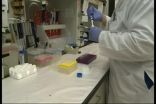Humans carry more antibiotic-resistant bacteria than animals they work with
Low potential health risk posed to workers in close contact with dairy herds and milk consumers through exposure to antibiotic-resistant staphylococci originating from milk, report researchers in Journal of Dairy Science®
2015-08-24
(Press-News.org) Philadelphia, PA, August 24, 2015 - Antibiotic-resistant bacteria are a concern for the health and well-being of both humans and farm animals. One of the most common and costly diseases faced by the dairy industry is bovine mastitis, a potentially fatal bacterial inflammation of the mammary gland (IMI). Widespread use of antibiotics to treat the disease is often blamed for generating antibiotic-resistant bacteria. However, researchers investigating staphylococcal populations responsible for causing mastitis in dairy cows in South Africa found that humans carried more antibiotic-resistant staphylococci than the farm animals with which they worked. The research is published in the Journal of Dairy Science®
Animal agriculture is often blamed for generating antibiotic-resistant bacteria through the "widespread" use of antibiotics. "South Africa has one of the highest HIV/AIDS and tuberculosis rates in the world and the human health risk to immune-compromised individuals is therefore that much greater," explained lead investigator Tracy Schmidt, a PhD candidate at the Department of Medical Microbiology, University of Pretoria, and a veterinary researcher at the KwaZulu-Natal (KZN) provincial Department of Agriculture and Rural Development in South Africa. "The rise of livestock-associated methicillin-resistant Staphylococcus aureus (LA-MRSA) and reported cases of bacterial transmission between dairy cows and humans has raised concerns from both the agriculture/veterinary sector and public health officials. The lack of data about the occurrence of LA-MRSA in South Africa and the need to investigate possible reservoirs were part of the motivation for this work."
Staphylococcus aureus is a contagious udder pathogen that readily spreads between cows at milking. The main source is milk from infected quarters, with milking machine teat liners playing a significant role in the transmission of the bacteria among cows and mammary quarters. Infected cows need to be promptly identified and appropriate control measures need to be taken to curb bacterial transmission among cows. Other Staphylococcus species, collectively referred to as coagulase-negative staphylococci (CNS), have traditionally been regarded as opportunistic pathogens of minor importance as mastitis caused by these bacteria is usually mild and remains subclinical However, the significance of CNS is being reassessed because, in many countries including South Africa, CNS have become the most common bacteria isolated from bovine IMI. Also of great importance is the fact that CNS often exhibit extensive resistance to antimicrobials and may serve as a reservoir of resistance genes that can transfer and supplement the genome of more pathogenic bacteria like Staphylococcus aureus.
This research in the KwaZulu-Natal province of South Africa investigated the diversity of Staphylococcus populations responsible for IMI in dairy cows and assessed the susceptibility of different species to antimicrobials commonly used in the veterinary field as well as human medicine. At the same time, individuals working in close contact with the animals were sampled and the diversity and susceptibility profiles of staphylococcal isolates determined and compared with isolates of animal origin.
With respect to staphylococcal diversity the results showed the clear predominance of Staphylococcus chromogenes among the CNS causing IMI, while Staphylococcus epidermidis was the isolate most commonly recovered from the human specimens.
The study found a relatively low occurrence of antimicrobial resistance among the bovine staphylococci. "This is encouraging as it indicates the responsible usage of antimicrobials within local dairies and provides our veterinary practitioners and animal owners valuable information going forward with respect to the treatment of infected animals," commented Schmidt. None of the staphylococcal isolates of bovine origin were found to be resistant to methicillin. Furthermore, all isolates tested negative for the presence of vancomycin-encoding genes - vancomycin being one of the front-line antimicrobials used for the treatment of methicillin-resistant staphylococcal infections in humans. The results indicate the low potential health risk posed to close contact workers and milk consumers through exposure to antibiotic-resistant staphylococci originating from milk.
"Of greatest interest was the extensive antimicrobial resistance noted among the coagulase-negative staphylococci of human origin. Multidrug resistance was common among isolates, and due to the propensity for staphylococci to acquire antimicrobial resistance through genetic exchange, human staphylococci can be regarded as a potential reservoir of resistance genes," added Schmidt.
"As an industry we are making great strides to reduce the use of blanket treatment of farm animals with antibiotics and the notion that antibiotic-resistant bacteria are moving from farm animals to humans has been debunked many times," observed Matt Lucy, PhD, Professor of Animal Science at the University of Missouri and Editor-in-Chief of the Journal of Dairy Science. "What the authors found is that the humans working with farm animals carry far more antibiotic-resistant staphylococci that the farm animals they work with. The risk, therefore, is the transfer from humans to farm animals and not from farm animals to humans as is often suggested."
INFORMATION:
ELSE PRESS RELEASES FROM THIS DATE:
2015-08-24
Cancer researchers are constantly in search of more-effective and less-toxic approaches to stopping the disease, and have recently launched clinical trials testing a new class of drugs called BET inhibitors. These therapies act on a group of proteins that help regulate the expression of many genes, some of which play a role in cancer.
New findings from The Rockefeller University suggest that the original version of BET inhibitors causes molecular changes in mouse neurons, and can lead to memory loss in mice that receive it. Published in Nature Neuroscience on August ...
2015-08-24
Resveratrol, a compound found commonly in grape skins and red wine, has been shown to have several potentially beneficial effects on health, including cardiovascular health, stroke prevention and cancer treatments. However, scientists do not yet fully understand how the chemical works and whether or not it can be used for treatment of diseases in humans and animals.
Now, researchers at the University of Missouri have found that resveratrol does affect the immune systems of dogs in different ways when introduced to dogs' blood. Sandra Axiak-Bechtel, an assistant professor ...
2015-08-24
In a new effort, researchers from the University of Pennsylvania and Baylor College of Medicine have used advanced imaging technology to fill in details about the underlying cause of canine diabetes, which until now has been little understood. For the first time, they've precisely quantified the dramatic loss of insulin-producing beta cells in dogs with the disease and compared it to the loss observed in people with type I diabetes.
"The architecture of the canine pancreas has never been studied in the detail that we have done in this paper," said Rebecka Hess, professor ...
2015-08-24
Black bears in Yosemite National Park that don't seek out human foods subsist primarily on plants and nuts, according to a study conducted by biologists at UC San Diego who also found that ants and other sources of animal protein, such as mule deer, make up only a small fraction of the bears' annual diet.
Their study, published in this week's early online edition of the journal Methods in Ecology and Evolution, might surprise bear ecologists and conservationists who had long assumed that black bears in the Sierra Nevada rely on lots of protein from ants and other insects ...
2015-08-24
For pregnant women who are at low risk of complications giving birth, the risk of newborn death and maternal complications is similar for obstetric deliveries by family physicians and obstetricians, according to a large study published in CMAJ (Canadian Medical Association Journal).
"It is common to assume that more specialized or higher-volume medical care will result in improved outcomes," writes Dr. Kris Aubrey-Bassler with the Primary Healthcare Research Unit, Discipline of Family Medicine, Memorial University of Newfoundland, St. John's, Newfoundland. "The obstetric ...
2015-08-24
A new Canadian guideline aims to ensure that pain during vaccination is minimized in both children and adults. The guideline, published in CMAJ (Canadian Medical Association Journal), is targeted at all health care providers who administer vaccines.
"Pain from vaccinations is common and can make people hesitate about getting future vaccines even as adults," states Dr. Anna Taddio, Senior Associate Scientist at The Hospital for Sick Children (SickKids), Toronto, Ontario, and Leslie Dan Faculty of Pharmacy, University of Toronto. "This can put people at risk of contracting ...
2015-08-24
Today's workforce is highly sex-segregated -- for example, most elementary school teachers are women, while most chemistry professors are men. Indiana University Bloomington researchers Bianca Manago, a doctoral student in sociology, and Cate Taylor, an assistant professor of sociology and gender studies, examine one important consequence of this occupational sex segregation: the stress exposure of women working in highly male-dominated occupations.
"We find that such women are more likely to experience exposure to high levels of interpersonal, workplace stressors," Manago ...
2015-08-24
Indiana's strict voter identification law may have prevented some elderly citizens from voting in the last two presidential elections, but there's little evidence it kept large numbers of voters from the polls, according to research by Indiana University Bloomington doctoral student Adam Nicholson.
Nicholson compared turnout figures in the 2000, 2004, 2008 and 2012 elections in Indiana and in Nebraska and Pennsylvania, two states without voter ID laws. Unlike most previous research on voter identification laws, the study examined data at the county level, not the state ...
2015-08-24
Atlanta, GA - August 24, 2015 - Individuals who received the flu vaccine were protected for up to 6 months post-vaccination, the duration of most flu seasons, according to a study presented at the 2015 International Conference on Emerging Infectious Diseases.
Each flu season, researchers work to find out how effective the flu vaccine was in order to measure its value as a health intervention. Factors such as age and health of an individual, as well the level of similarity between the flu virus and the flu vaccine can play a role in how well an influenza vaccine works.
"Few ...
2015-08-24
New research into the impact of climate change has found that warming oceans will cause profound changes in the global distribution of marine biodiversity.
In a study published in the journal Nature Climate Change an international research team modelled the impacts of a changing climate on the distribution of almost 13 thousand marine species, more than twelve times as many species as previously studied.
The study found that a rapidly warming climate would cause many species to expand into new regions, which would impact on native species, while others with restricted ...
LAST 30 PRESS RELEASES:
[Press-News.org] Humans carry more antibiotic-resistant bacteria than animals they work with
Low potential health risk posed to workers in close contact with dairy herds and milk consumers through exposure to antibiotic-resistant staphylococci originating from milk, report researchers in Journal of Dairy Science®


